Deadhorse is a 21st-century version of a Wild West town and it strikes me as a place where just about anything could happen. Well, almost anything: there’ll be no shoot-out at the OK Corral saloon bar because there ain’t no saloon in town. In fact, there’s very little that constitutes a town – just one shop, hardware mainly, with some stickers and T-shirts as an afterthought, and an unmanned gas station. There’s no church and no main square, in fact there’s no public square at all. There are places to work, big heavy industrial places – land-based oil rigs and the contract operations that serve them – and places to sleep – modular blocks - and eat, and that’s about it. Deadhorse is dry, totally dry, because of the dangers alcohol poses. Oil-drilling operators and the heavy industrial contractors cannot afford a worker operating below-par the day after a night on the tiles.
But some weird things do happen in Deadhorse, I’ll say that.
I’m on the bike at about 8am heading for Deadhorse Camp, a sort of hostel, from where I’ll join the tour of the Prudhoe Oilfield. I’m on the last of three vehicles approaching a bend in the road when the first car comes to a halt. The bus in front of me, and behind the car, also stops. And so do I. Initially, I don’t know why we’ve all stopped and then the car starts to reverse and I see the reverse lights of the bus light up. I start to shuffle myself backwards, still not knowing what’s going on. And then I look ahead where the road turns sharply left, and where we were all about to go.
There’s a bear, a very, very large brown bear, ambling along on all fours, with no obvious sense of mission, from what I could see anyway, but ambling towards us for sure. He’s a grizzly bear, which I can tell by the hump on his back around about where his shoulder blades are – a defining characteristic of the grizzly. He really is quite large, about the size of a short-legged bull, and although he’s ambling with a sort of lumbering motion, he has that way about him that has me thinking: “he looks like he could run very fast if he wanted to”.
RM Block
I pull over to the left side of the road and start fumbling urgently for my phone to take pictures as Mr Grizzly moves along the right side, where the vehicles are and where another one has joined the queue behind me. I can see people in the cars are sort of freaking out and the bear apparently tried to open one of the car doors, grabbling the handle in his mouth. My efforts to video Mr Bear fail miserably as, simultaneously, I realise that I too better hightail it out of there, which I do, making in the process a two-second video of, I think, the road surface.
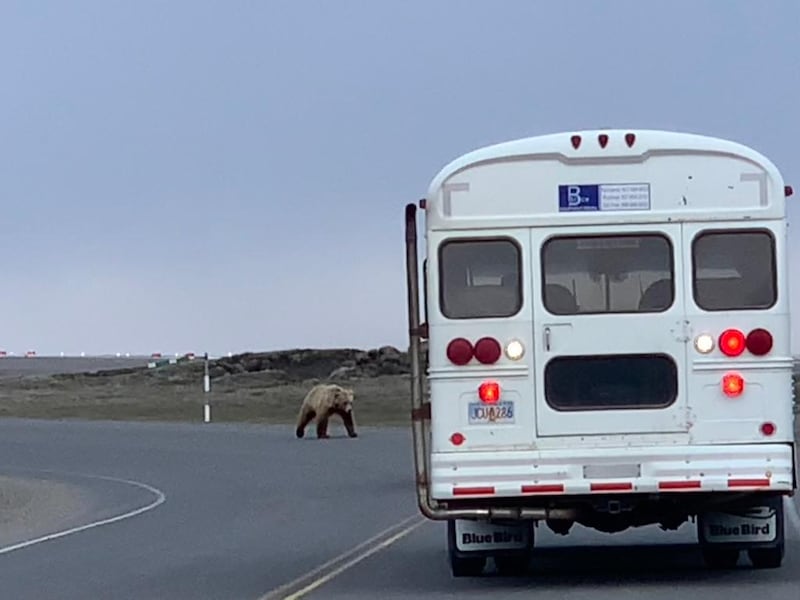
“Oh, you’re the guy who was on the bike!” exclaims Sher from Oregon, when she arrives at the Camp, also for the tour, she having been in the other car to pull into the bear queue just behind me. “Oh my God!” she says and then we have the “where are you from?” conversation and Sher, the other 20 or so people about to embark on the tour, plus the guide, are all very congratulatory about my journey. Yes, I said, it’s been a long one and this is the end ...
[ Meet the Bearman of Buncrana: ‘I knew about Joe Exotic for years’Opens in new window ]
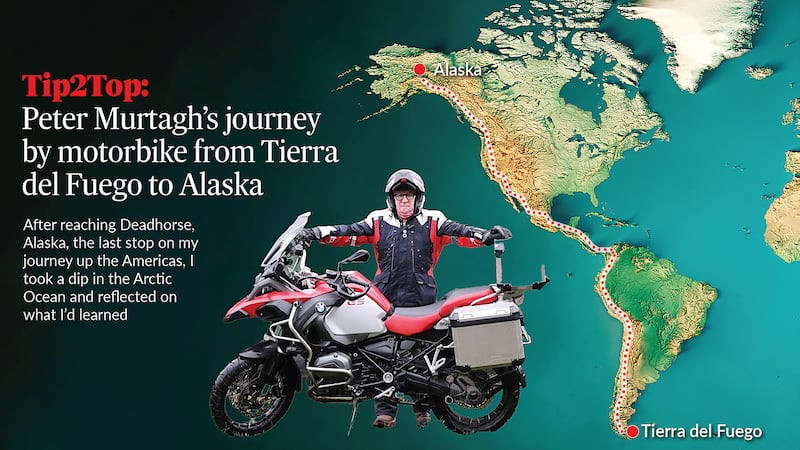
I had pulled into Deadhorse the night before, 797km north of Fairbanks. My odometer was showing 37,204 miles, not kilometres because the bike was bought in the UK. Of those, 13,941 were done before I started this trip. So I reckon it’s been a 23,263-mile adventure, give or take. That’s 37,438 kilometres and at this juncture, I don’t really know what my feelings are. I have a sort of detached conversation with myself in which I say, “well, there you are now, you’ve done it,” and to which I reply to myself, “well, yes, I suppose I have,” and fall silent, not knowing what to think or say to myself next.
What have I learned? A lot confirmed, is how I’d put it. First, people everywhere are mostly good and kind and will help you, if asked. Latin America is mostly safe; the US, or parts of it, scares me more. Inequality, gross inequality such as I saw many times in Latin America, is wrong and it’s not all the fault of the US. Many times over, people elect idiots, liars and cheats, fully knowing they are idiots, liars and cheats who will do them no good at all. Being Irish is a huge, huge positive. Everywhere. And the Dalton Highway, my last road, is perhaps the greatest adventure biking road on earth.
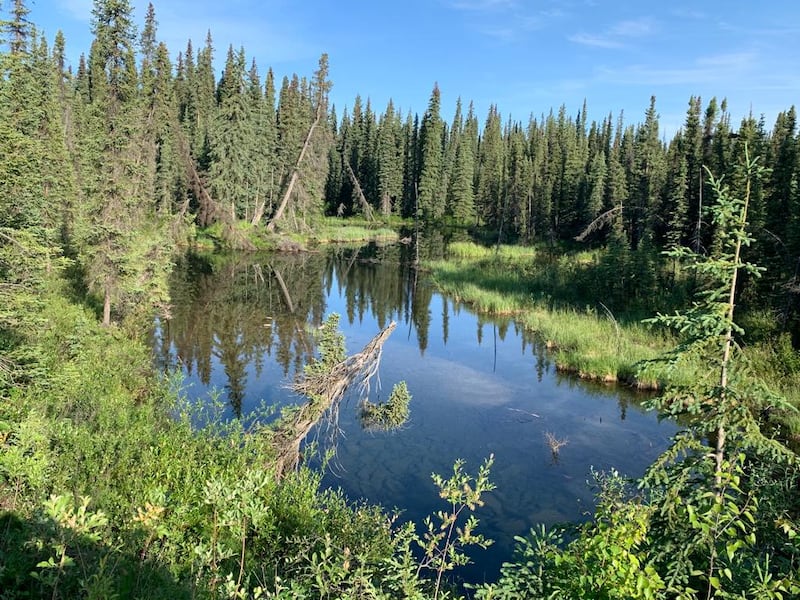
It is named in honour of the late James P Dalton, an Alaskan mining engineer and oil prospector in the tundra area between the Brooks Range and Prudhoe Bay, which is known as the North Slope. The highway was built not by him but by the Alaskan oil industry after confirmation, in 1968, that oil existed in Prudhoe. It was initially a haul road for building the Alaska Oil Pipeline, the 1,300km crude oil feedline from Prudhoe to Valdez in southern Alaska. Finding the oil was like a second Alaskan gold rush: the road was built in an incredible 154 days, with 32 million cubic yards of gravel, and the pipeline in just three years, from March 1975 to May 1977. Crude oil began flowing, at 100 degrees Fahrenheit, in 1977 and takes two weeks to reach Valdez. Construction workers, some of whom were Irish, could earn $1,000 to $1,500 a week. Today, the pay in the oilfield is $150,000 (€138,000) a year.
[ The Irish who helped build the trans-Alaskan oil pipelineOpens in new window ]
The pipeline is visible everywhere between Fairbanks and Prudhoe because it runs almost entirely above ground, on steel stilts, about 10 feet tall, sometimes in a straight line, sometimes zigzagging to help it survive earthquakes. The oil-carrying pipe is four feet in diameter but it is sheathed in protective and insulating material making it look fatter. Lots of signs warn the curious to stay away from it and not to climb on to it. The pipeline is a scar on the landscape for sure but I can’t say it has destroyed it – it’s there, yes, but then so is everything else, the scenery, the forests, plants and wildlife, and when the oil runs out, it is supposed to be removed.
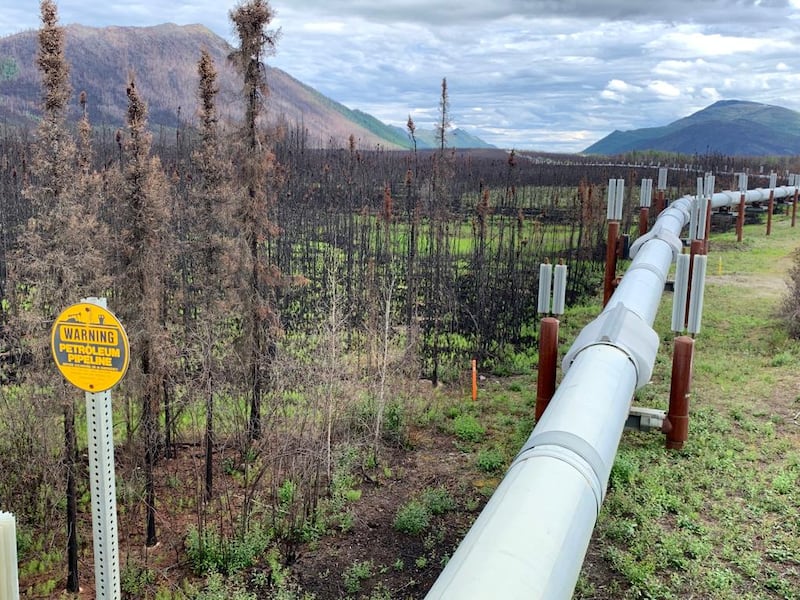
Once I got on to the Dalton, just beyond Livengood, some 134km north of Fairbanks, I settled into the final ride of this adventure and soon found my anxiety easing. The gravel was hard packed and, crucially, there weren’t greats drifts of it into which a front wheel might sink, causing the bike to shimmy and maybe topple over, me with it. In no time at all I was tootling along at 50km/h, even when the gravel gave way to stretches of hard-packed mud. Fairly early on, there were big road works, perhaps about 20km long, where there were lots of diggers, earth movers, dozers, traffic cones, red flags and traffic restrictions. Sometimes one side of the road was closed to traffic and a stop/go system operated for the other side, with cars and trucks being led, when they were allowed to proceed, by a pilot car with a large “Follow Me” sign on the back.
It starts to rain and my heart sinks. The mud surface turns slippery and tyre-track gullies form from the lorries. But, as I’ve learned by this stage, the best tactic is to keep going at a steady, if reduced speed, 20 or 30km/h for instance, sometimes standing on the footrests (the pegs) for balance and control. It’s strange, but what seems like an inherently unstable tactic actually gives you far greater control – up on the pegs, lean forward, knees clasping the tank and used to jerk the bike away from big holes, rocks or, worst of all, slithery, gloopy canals of mud. I’ve good tyres on – Heidenau Scout K60s – and they hold up really well.
The roadworks end, the pilot car pulls over and I’m through – elated not to have fallen over.I feel now I really can do this, I am up to the challenge. I feel great and the sense of Wow! is reinforced when I reach Yukon Crossing, an early staging post 224km out from Fairbanks, where the Dalton crosses the mighty river and it really is mighty here - enormously wide, a couple of hundred meters I’d say, and starting to enter its old man stage as it moves towards the Bering Sea. Just after the crossing, there’s a campsite called Five Mile Campground which is, by strange coincidence, five miles after the crossing.
[ Have you been to ‘Queen Maeve’s Vulva’? Ireland’s oddest placenamesOpens in new window ]
Amid a blizzard of mosquitos kept at bay by a face net, I get the tent up. The midnight sun keeps it daytime all the time at this time of year and so I go to sleep in sunshine, and wake up in it too. In between, it rained like hell and so I’m nervous about the road once again, but the first challenge is how to get up and dressed without being eaten alive.
Leaving Five Mile Campground, the road soon rises gently to a plateau named Finger Mountain – so called because of the granite protrusions that in some instances resemble an upright finger sticking out of the bog-like ground. Views of the mountains to the north and east are obscured partly by long streaks of low, early-morning clouds but, through them, it is still possible to seek snow-flecked mountain tops and winding rivers in the flat-floor valleys between them.
At the crest of the next hill, which is named, ominously, Beaver Slide, just before I start to descend, a driver coming up lowers his window and shouts out a warning at me: “Muddy. Really muddy ...” I start the descent fearing the worst but, again, everything is okay - his side of the road looked like thick gravy Plasticine but on mine the ground is firm and easily driven. I reach the Arctic Circle – 318km north of Fairbanks – my second time to cross it (the first being north of Bodø in Norway about 44 years ago).
At Coldfoot, 414km from Fairbanks (and 383km from Deadhorse), there’s petrol and coffee, and food if wanted. I ask the girl behind the counter how long to Deadhorse? “Five to 12 hours,” she says, “depending how fast you go.” It was coming up to midday and so I reckoned I could do it in seven or eight hours – lots of time, especially with 24-hour daylight. And this part of the journey proves to be the most magical, the most breathtaking, jaw-dropping part of the whole Dalton. The scenery is just incredible.
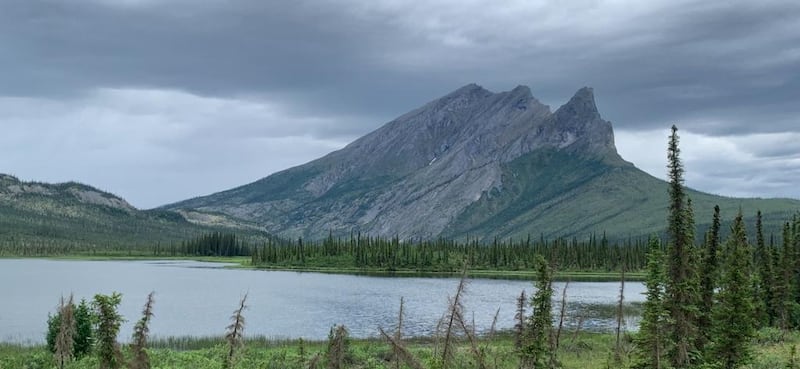
There’s a valley, much of it with a tarmac road, that passes mountains that are massive in scale – bare rock mountains with jagged edges and coloured rockfaces, towering over rivers and lakes, a raw landscape from which trees are slowly being banished as the road surges northwards. One of the mountains is Sukakpak (1,338m) – jagged and angular, it juts upwards like a broken plank sticking out of the earth. Opposite it, there’s a long bare escarpment above the tree line, an enormous mountain of grey rock with rust-coloured minerals bleeding from it. The valley leads into the Atigun Pass, the final mountain hurdle through the Brooks Range, where the partly snow-covered mountains are black and look doom-laden, and landslides are a permanent menace preventing any stopping on the road.
I’d been warned by a guide at the Arctic Visitor Centre in Coldfoot that this potentially would be the most difficult part of the road, with unstable gravel and lots of mud. But it wasn’t a problem; the bike handled it without demur (as it did everything on this long, long trip), even though heavy rain was making it almost impossible at times to see clearly ahead.
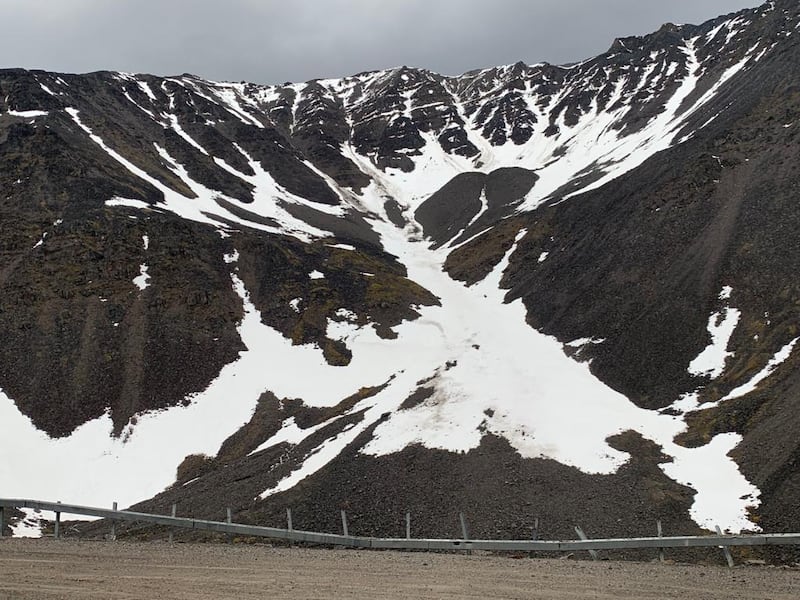
The highway fell on to rolling landscape that would soon drop again, on to tundra flat as a pancake. Deadhorse was but 270km away. And as I near the end, the struggle between land and ocean sees the landscape become more and more blotched with rivers and lakes and bits of estuary – the wild, bare, windswept and uninhabited Arctic save for low-growing tundra shrubbery and flowers, birds, caribou and other mammals ... plus oil workers and adventure visitors.
Officially, no one lives in Deadhorse. They are all transitory – some 5,000 oil workers and about the same again of contractors. The oilfield has 1,400 wells, of which 800 are active. And despite all the heavy industry, nature is everywhere.
“On the right,” says Jack, the guide and bus driver on our oilfield tour, “caribou”. And there, strolling between huge lumps of frontier industry, are half a dozen of the beautiful reindeers, most of them with impressive antlers. An arctic fox, with his dark summer coat on, appears bounding across the tundra. “He’ll be looking for birds eggs,” says Jack. “On the left, a Brent goose – now, he’s quite rare – those over there are cackling geese. They look quite like Canada geese but have a shorter neck ...”
We see great white-fronted geese, a snow goose, tundra swan, long-tailed sea ducks and red-necked phalaropes. Jack says that polar bears are not really a problem in Deadhorse, contrary to what I had been told, but grizzlies are. That much I know personally. Polar bears do hang out over at a seawater treatment plant, further away, say Jack.
He took us down to the sea – Prudhoe Bay, the Arctic Ocean – and some of us got in. They all stood cheering when I got out, and that’s when it hit me, that’s when I felt a bit emotional. This truly was the end. I had left Puerto Williams, the southernmost settlement in Chile, south of Ushuaia, on November 22nd, 2022 and been riding my bike most every day since then. Now it was over.
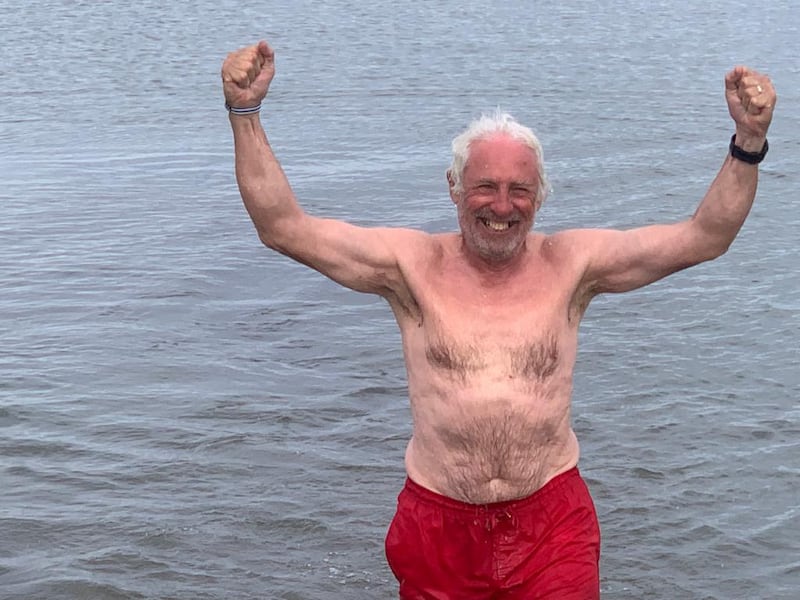
I had spent the night in the 432-room Aurora Hotel, serving contractors mainly, a building with all the charm of a prison block, and now looked across the tundra at the Brooks Range, clear and sharp in the sun, despite the distance. Once again, I saw the Atigun Pass, the valleys, the extraordinary mountains, the rushing rivers and turquoise lakes.
The day was bone dry and on that long, flat, compacted mud section of the Dalton before Yukon Crossing, I opened the throttle, stood upright on the pegs, lened forward and hit 70mph. 70.
Aged 70 and on the pegs.
Top of the world, Ma. Top of the world!
Peter Murtagh travelled by motorbike from Tierra del Fuego, at the tip of South America, to Alaska, at the top of North America, and wrote here regularly. You can also read his blog and follow him on Twitter, Facebook and Instagram























